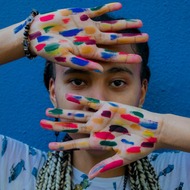
(View Complete Item Description)
Intergenerational Stories
A Lesson Developed and Contributed by Christine Hennig, MA, LMHP, ATR With a Link to Copyrighted Dick Blick Lesson Plan “Home Town Map” www.DickBlick.com
Objectives (Elders):
1. To encourage reminiscence, which has been shown to be beneficial for elders
2. To increase feelings of self-worth by discovering that elders have interesting stories to tell about their lives
3. To increase feelings of self-worth by passing on their wisdom to young people
4. To brighten moods through contact with young people
Objectives (Children):
1. To bring history lessons they may have learned in school to life through contact with people who have “lived it”
2. To encourage respect for elders by discovering what they have lived through and learned from their experiences
3. To increase tolerance for disability and aging
Audiences:
This is a project to complete with a small group of elderly people plus a small group of school-aged children. It is recommended that you have group facilitators for both the elders and the children (i.e., at least two—one for the elders and one for the children). Elders should be high-functioning and be able to tell their stories. Elders with mild dementia, but still good long-term memories, can be involved if there is extra staff or volunteers available to work one-on-one with them and the children to encourage and guide.
Material Type:
Activity/Lab,
Lesson,
Lesson Plan
Author:
NDE Digital Learning



















